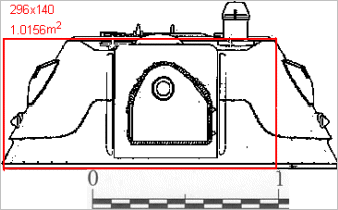|
T-34 Nose Girder Casting Armor |
||


|
Let's take a real close look at the armor basis of the T-34 bow/nose girder. This is the cast piece that joins the two armor plates at the front of the T-34. |
||
|
68mm coverage in the vertical. |
||

|
Click to enlarge |
||

|
Early style nose casting on the left. New style on the right. Numbers in red are actual thickness. Numbers in green are normalized basis per quality. The numbers in blue are the vertical heights that contribute 10cm and 11cm of protection. |
||
|
Welds are considered to be of 0.89 relative quality while 45-46mm rolled homogenous plates are 1.0 quality. Values are prorated where they overlap. |
||


|
Above - the area of the T-34/76 turret is about 1.02 m2. Right - the area of the T-34/85 turret is about 1.63 m2. The total area of the T-34/76 = 3.25m2 and the T-34/85 = 3.86m2. The percentage that is covered 10cm or better for the old style bow is 6.67% For the T-34/85 the surface area of the bow that is covered by 10cm or more is 3.05%. |
||
|
3.05%. |
||

|
Comparison of armor values |
||
|
* The relative quality increase in curved 90mm cast armor of the Sherman turret could also be attributed to a deflection angle of 11.5°. There's no way to know. |
||
|
85mm gun penetration. |
||


